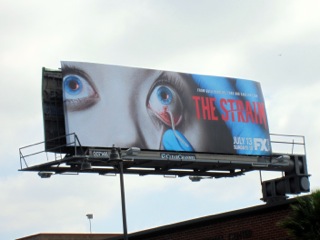
“Mommy?” I look in the rear-view mirror at my 6-year-old daughter. Her brow is furrowed and her mouth turned down as she stares at something out the window. “I don’t want to go this way to camp anymore,” she says.
I know exactly what she saw at the corner of Pico and Bundy in West Los Angeles. It’s CBS Outdoor billboard number 14461A, advertising FX’s The Strain. At the bottom of a giant blue eyeball, a silver worm that looks like a sharp hook pokes through the sclera.
For adults, the image is provocative. For young children, it can be terrifying. A friend told me that her 4-year-old son couldn’t sleep after seeing the image, asking repeatedly, “Mommy, will there be a worm in my eye?” From parents at my daughter’s school, on a parenting listserv, and on Facebook, I heard the same story repeated.
The ad created enough uproar to be covered in Entertainment Weekly, AdWeek and Deadline Hollywood. At the Directors Guild of America premiere of The Strain on July 10, FX CEO John Landgraf addressed the controversy: “We had to terrify some children in order to launch this show, but I think it was worth it. Just saying.”
Guillermo del Toro, co-creator of the series and the book that inspired it, similarly made light of the furor. “Look, honestly, I find every other form of advertising more morally disturbing. Beer commercials, aftershave. This is just a [expletive] worm in the eye!”
After my initial outrage over Landgraf and del Toro’s words, I decided to take them as a serious inquiry: Does the financial success of a TV show justify frightening some children? Is a “[expletive]” worm in the eye that bad? And does the public have any rights over the advertising images that fill outdoor space?
The storm over the ads certainly didn’t hurt the profile of The Strain. The show aired on Sunday, July 13, with nearly 3 million viewers, significantly higher than FX’s other recent debuts.
Defenders of the campaign told parents to explain the ads to their children, or tell them to look away. But it is difficult-to-impossible to unfrighten a young child through explanation. Children under 8 years of age are still working out the boundaries between fantasy and reality. Many children don’t yet have the verbal and cognitive tools to process their fears through talking.
My daughter, who is less sophisticated than del Toro, is not yet scared by ads for aftershave or beer. By the time my kids are old enough to possibly find them “morally disturbing,” they will be old enough for a rational discussion about them.
The dilemma parents face with outdoor advertising is that we cannot choose whether our children see a billboard or signs plastered on public transportation and transit shelters.
Movies for general audiences must meet certain standards set by the Motion Picture Association of America. Parents can boycott films they feel contain inappropriate content and are rated improperly. It’s uncertain whether the organization that controls billboards — the Outdoor Advertising Association of America — would or could implement a similar system.
On June 27, a group of parents succeeded in removing a billboard ad for The Strain near LAX within 24 hours, by calling Clear Channel and the city council. The next day, FX responded to angry calls and tweets and the negative press by announcing that ads would be replaced “in several locations.” But the billboard 14461A on my route, and others parents reported to me, stayed up for three more weeks.
When I called CBS Outdoor, which owns billboard 14461A, Craig Rosato, its general sales manager, told me that the company is contractually bound to display copy for a client for a fixed period and cannot immediately pull an ad. The contract does not directly link CBS Outdoor with FX — the promotional buys are handled by intermediary agencies. Going through this chain to get approval to pull an ad takes time, Rosato explained.
State and local governments currently have limited authority when it comes to offensive ads. Fred Sutton, a field deputy for council member Mike Bonin’s office, wrote to a parent with support, but cautioned about First Amendment issues: “We are only allowed to regulate signage within narrow parameters, and the city’s ability to require that the content of a billboard be changed or removed is strictly limited by law.”
Yet the few regulations in place are clearly intended to protect children. Tobacco products have been banned from outdoor advertising nationally since 1999, and the City of Los Angeles code forbids “obscene” (“prurient” or sexual) content. The California Outdoor Advertising Act and Regulations ban a “matter or thing of an obscene, indecent or immoral character.” Many parents — and nonparents — would agree that The Strain ads offend public decency.
Existing laws should be expanded to limit gory and/or violent content, images that are at least as distressing to young minds as sexual ones. While the ad at billboard No. 14461A finally came down on July 21, it’s only a matter of time before another horror movie or TV series needs promotion.
Anoosh Jorjorian blogs on parenting and politics at ArañaMama. She has also written for Salon, the Huffington Post, AlterNet, Black Girl Dangerous and Racialicious. This piece originally appeared at Zocalo Public Square.
More Must-Reads From TIME
- The 100 Most Influential People of 2024
- The Revolution of Yulia Navalnaya
- 6 Compliments That Land Every Time
- What's the Deal With the Bitcoin Halving?
- If You're Dating Right Now , You're Brave: Column
- The AI That Could Heal a Divided Internet
- Fallout Is a Brilliant Model for the Future of Video Game Adaptations
- Want Weekly Recs on What to Watch, Read, and More? Sign Up for Worth Your Time
Contact us at letters@time.com